Financial Management Report: Valuation, Appraisal, and Policy
VerifiedAdded on 2023/01/09
|18
|3738
|71
Report
AI Summary
This report provides a detailed analysis of key financial management concepts. It begins with an introduction to financial management and its importance, followed by an in-depth examination of mergers and takeovers, including valuation methods like price-earnings ratio, dividend valuation model, and discounted cash flow, along with their advantages and disadvantages. The report then explores investment appraisal techniques, such as payback period, net present value, and internal rate of return, with calculations and recommendations. The assignment also addresses dividend policy, discussing factors for determining dividend size and practical considerations for a listed company. The report uses Lovewell Limited as a case study to determine investment decisions.

Financial Management
Paraphrase This Document
Need a fresh take? Get an instant paraphrase of this document with our AI Paraphraser

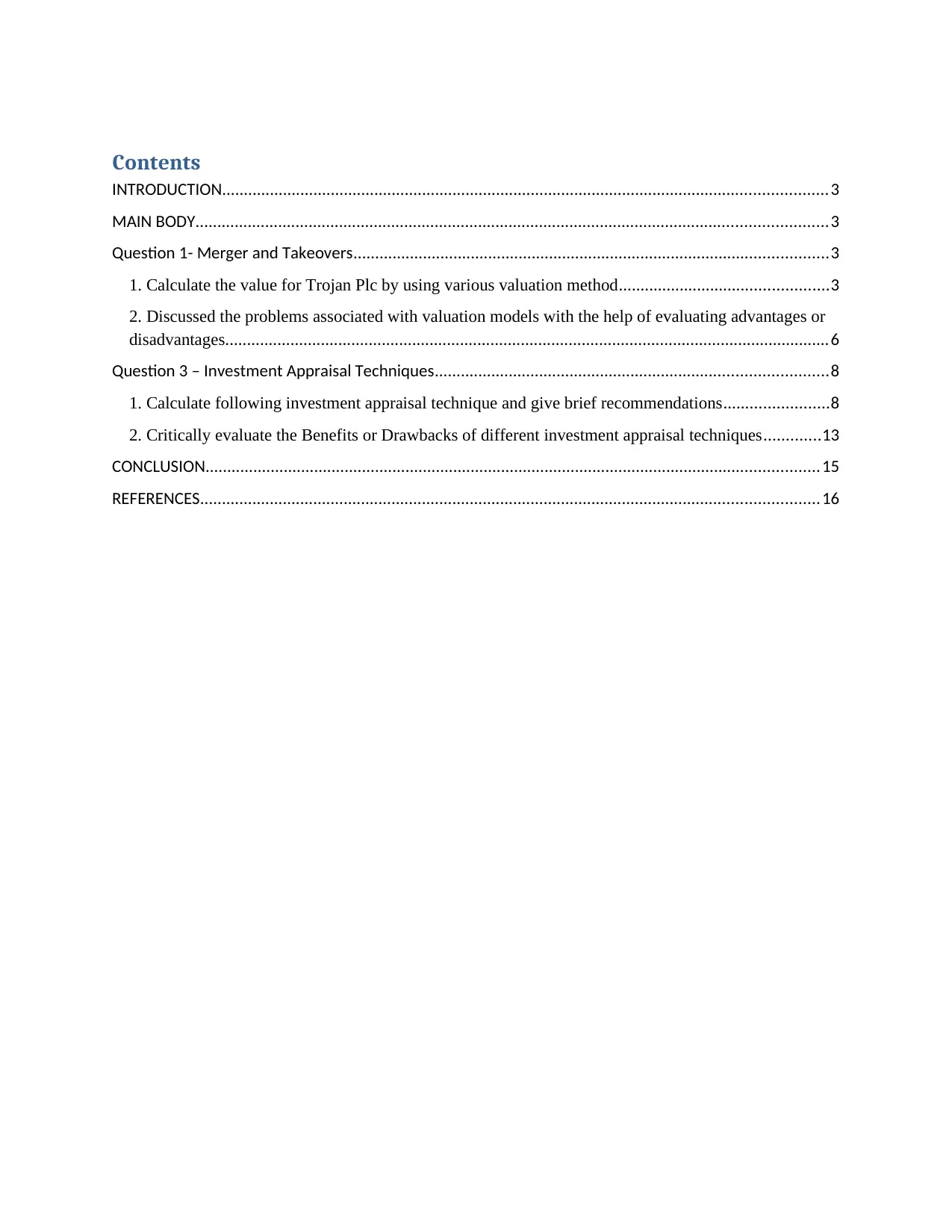
Contents
INTRODUCTION...........................................................................................................................................3
MAIN BODY.................................................................................................................................................3
Question 1- Merger and Takeovers.............................................................................................................3
1. Calculate the value for Trojan Plc by using various valuation method................................................3
2. Discussed the problems associated with valuation models with the help of evaluating advantages or
disadvantages...........................................................................................................................................6
Question 3 – Investment Appraisal Techniques..........................................................................................8
1. Calculate following investment appraisal technique and give brief recommendations........................8
2. Critically evaluate the Benefits or Drawbacks of different investment appraisal techniques.............13
CONCLUSION.............................................................................................................................................15
REFERENCES..............................................................................................................................................16
INTRODUCTION...........................................................................................................................................3
MAIN BODY.................................................................................................................................................3
Question 1- Merger and Takeovers.............................................................................................................3
1. Calculate the value for Trojan Plc by using various valuation method................................................3
2. Discussed the problems associated with valuation models with the help of evaluating advantages or
disadvantages...........................................................................................................................................6
Question 3 – Investment Appraisal Techniques..........................................................................................8
1. Calculate following investment appraisal technique and give brief recommendations........................8
2. Critically evaluate the Benefits or Drawbacks of different investment appraisal techniques.............13
CONCLUSION.............................................................................................................................................15
REFERENCES..............................................................................................................................................16
⊘ This is a preview!⊘
Do you want full access?
Subscribe today to unlock all pages.

Trusted by 1+ million students worldwide
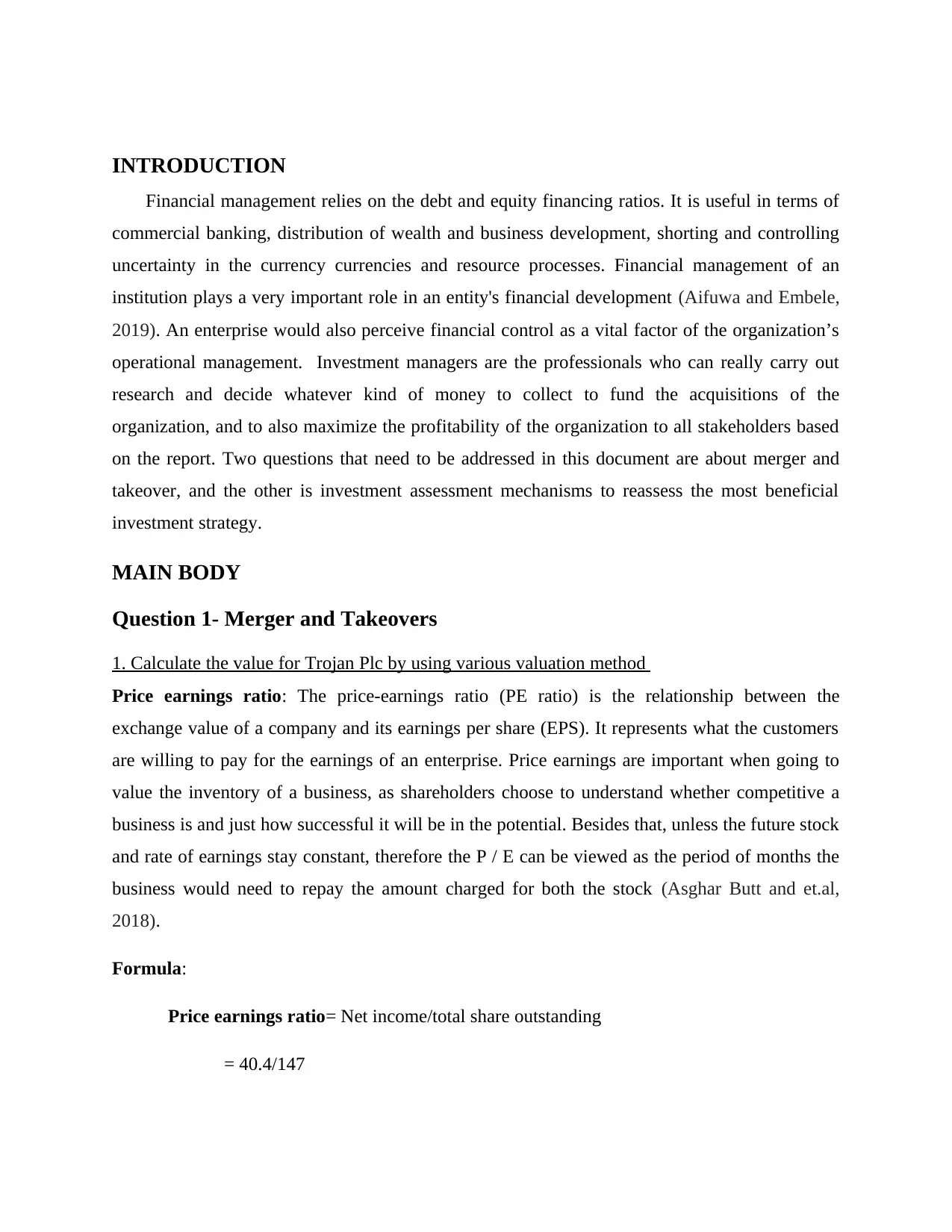
INTRODUCTION
Financial management relies on the debt and equity financing ratios. It is useful in terms of
commercial banking, distribution of wealth and business development, shorting and controlling
uncertainty in the currency currencies and resource processes. Financial management of an
institution plays a very important role in an entity's financial development (Aifuwa and Embele,
2019). An enterprise would also perceive financial control as a vital factor of the organization’s
operational management. Investment managers are the professionals who can really carry out
research and decide whatever kind of money to collect to fund the acquisitions of the
organization, and to also maximize the profitability of the organization to all stakeholders based
on the report. Two questions that need to be addressed in this document are about merger and
takeover, and the other is investment assessment mechanisms to reassess the most beneficial
investment strategy.
MAIN BODY
Question 1- Merger and Takeovers
1. Calculate the value for Trojan Plc by using various valuation method
Price earnings ratio: The price-earnings ratio (PE ratio) is the relationship between the
exchange value of a company and its earnings per share (EPS). It represents what the customers
are willing to pay for the earnings of an enterprise. Price earnings are important when going to
value the inventory of a business, as shareholders choose to understand whether competitive a
business is and just how successful it will be in the potential. Besides that, unless the future stock
and rate of earnings stay constant, therefore the P / E can be viewed as the period of months the
business would need to repay the amount charged for both the stock (Asghar Butt and et.al,
2018).
Formula:
Price earnings ratio= Net income/total share outstanding
= 40.4/147
Financial management relies on the debt and equity financing ratios. It is useful in terms of
commercial banking, distribution of wealth and business development, shorting and controlling
uncertainty in the currency currencies and resource processes. Financial management of an
institution plays a very important role in an entity's financial development (Aifuwa and Embele,
2019). An enterprise would also perceive financial control as a vital factor of the organization’s
operational management. Investment managers are the professionals who can really carry out
research and decide whatever kind of money to collect to fund the acquisitions of the
organization, and to also maximize the profitability of the organization to all stakeholders based
on the report. Two questions that need to be addressed in this document are about merger and
takeover, and the other is investment assessment mechanisms to reassess the most beneficial
investment strategy.
MAIN BODY
Question 1- Merger and Takeovers
1. Calculate the value for Trojan Plc by using various valuation method
Price earnings ratio: The price-earnings ratio (PE ratio) is the relationship between the
exchange value of a company and its earnings per share (EPS). It represents what the customers
are willing to pay for the earnings of an enterprise. Price earnings are important when going to
value the inventory of a business, as shareholders choose to understand whether competitive a
business is and just how successful it will be in the potential. Besides that, unless the future stock
and rate of earnings stay constant, therefore the P / E can be viewed as the period of months the
business would need to repay the amount charged for both the stock (Asghar Butt and et.al,
2018).
Formula:
Price earnings ratio= Net income/total share outstanding
= 40.4/147
Paraphrase This Document
Need a fresh take? Get an instant paraphrase of this document with our AI Paraphraser
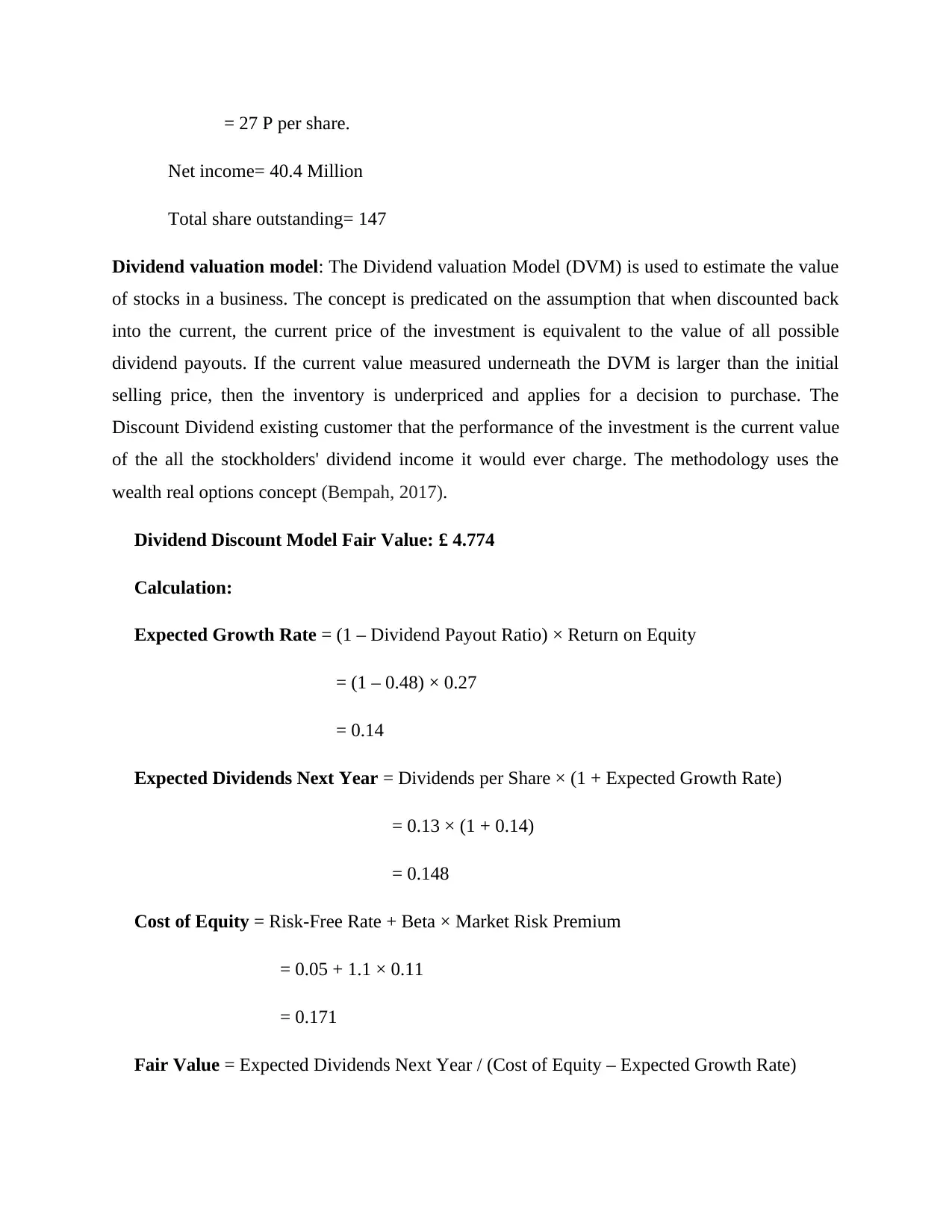
= 27 P per share.
Net income= 40.4 Million
Total share outstanding= 147
Dividend valuation model: The Dividend valuation Model (DVM) is used to estimate the value
of stocks in a business. The concept is predicated on the assumption that when discounted back
into the current, the current price of the investment is equivalent to the value of all possible
dividend payouts. If the current value measured underneath the DVM is larger than the initial
selling price, then the inventory is underpriced and applies for a decision to purchase. The
Discount Dividend existing customer that the performance of the investment is the current value
of the all the stockholders' dividend income it would ever charge. The methodology uses the
wealth real options concept (Bempah, 2017).
Dividend Discount Model Fair Value: £ 4.774
Calculation:
Expected Growth Rate = (1 – Dividend Payout Ratio) × Return on Equity
= (1 – 0.48) × 0.27
= 0.14
Expected Dividends Next Year = Dividends per Share × (1 + Expected Growth Rate)
= 0.13 × (1 + 0.14)
= 0.148
Cost of Equity = Risk-Free Rate + Beta × Market Risk Premium
= 0.05 + 1.1 × 0.11
= 0.171
Fair Value = Expected Dividends Next Year / (Cost of Equity – Expected Growth Rate)
Net income= 40.4 Million
Total share outstanding= 147
Dividend valuation model: The Dividend valuation Model (DVM) is used to estimate the value
of stocks in a business. The concept is predicated on the assumption that when discounted back
into the current, the current price of the investment is equivalent to the value of all possible
dividend payouts. If the current value measured underneath the DVM is larger than the initial
selling price, then the inventory is underpriced and applies for a decision to purchase. The
Discount Dividend existing customer that the performance of the investment is the current value
of the all the stockholders' dividend income it would ever charge. The methodology uses the
wealth real options concept (Bempah, 2017).
Dividend Discount Model Fair Value: £ 4.774
Calculation:
Expected Growth Rate = (1 – Dividend Payout Ratio) × Return on Equity
= (1 – 0.48) × 0.27
= 0.14
Expected Dividends Next Year = Dividends per Share × (1 + Expected Growth Rate)
= 0.13 × (1 + 0.14)
= 0.148
Cost of Equity = Risk-Free Rate + Beta × Market Risk Premium
= 0.05 + 1.1 × 0.11
= 0.171
Fair Value = Expected Dividends Next Year / (Cost of Equity – Expected Growth Rate)
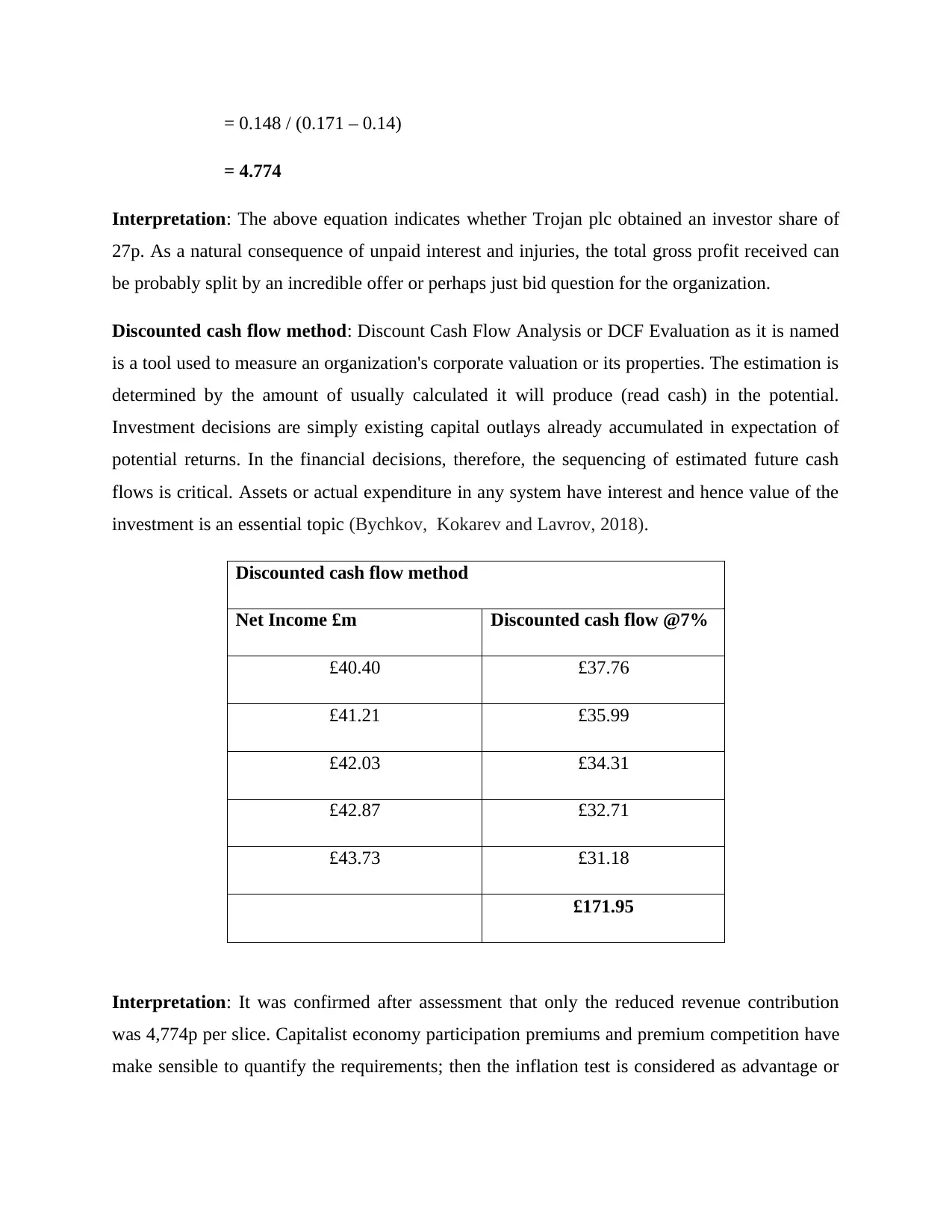
= 0.148 / (0.171 – 0.14)
= 4.774
Interpretation: The above equation indicates whether Trojan plc obtained an investor share of
27p. As a natural consequence of unpaid interest and injuries, the total gross profit received can
be probably split by an incredible offer or perhaps just bid question for the organization.
Discounted cash flow method: Discount Cash Flow Analysis or DCF Evaluation as it is named
is a tool used to measure an organization's corporate valuation or its properties. The estimation is
determined by the amount of usually calculated it will produce (read cash) in the potential.
Investment decisions are simply existing capital outlays already accumulated in expectation of
potential returns. In the financial decisions, therefore, the sequencing of estimated future cash
flows is critical. Assets or actual expenditure in any system have interest and hence value of the
investment is an essential topic (Bychkov, Kokarev and Lavrov, 2018).
Discounted cash flow method
Net Income £m Discounted cash flow @7%
£40.40 £37.76
£41.21 £35.99
£42.03 £34.31
£42.87 £32.71
£43.73 £31.18
£171.95
Interpretation: It was confirmed after assessment that only the reduced revenue contribution
was 4,774p per slice. Capitalist economy participation premiums and premium competition have
make sensible to quantify the requirements; then the inflation test is considered as advantage or
= 4.774
Interpretation: The above equation indicates whether Trojan plc obtained an investor share of
27p. As a natural consequence of unpaid interest and injuries, the total gross profit received can
be probably split by an incredible offer or perhaps just bid question for the organization.
Discounted cash flow method: Discount Cash Flow Analysis or DCF Evaluation as it is named
is a tool used to measure an organization's corporate valuation or its properties. The estimation is
determined by the amount of usually calculated it will produce (read cash) in the potential.
Investment decisions are simply existing capital outlays already accumulated in expectation of
potential returns. In the financial decisions, therefore, the sequencing of estimated future cash
flows is critical. Assets or actual expenditure in any system have interest and hence value of the
investment is an essential topic (Bychkov, Kokarev and Lavrov, 2018).
Discounted cash flow method
Net Income £m Discounted cash flow @7%
£40.40 £37.76
£41.21 £35.99
£42.03 £34.31
£42.87 £32.71
£43.73 £31.18
£171.95
Interpretation: It was confirmed after assessment that only the reduced revenue contribution
was 4,774p per slice. Capitalist economy participation premiums and premium competition have
make sensible to quantify the requirements; then the inflation test is considered as advantage or
⊘ This is a preview!⊘
Do you want full access?
Subscribe today to unlock all pages.

Trusted by 1+ million students worldwide
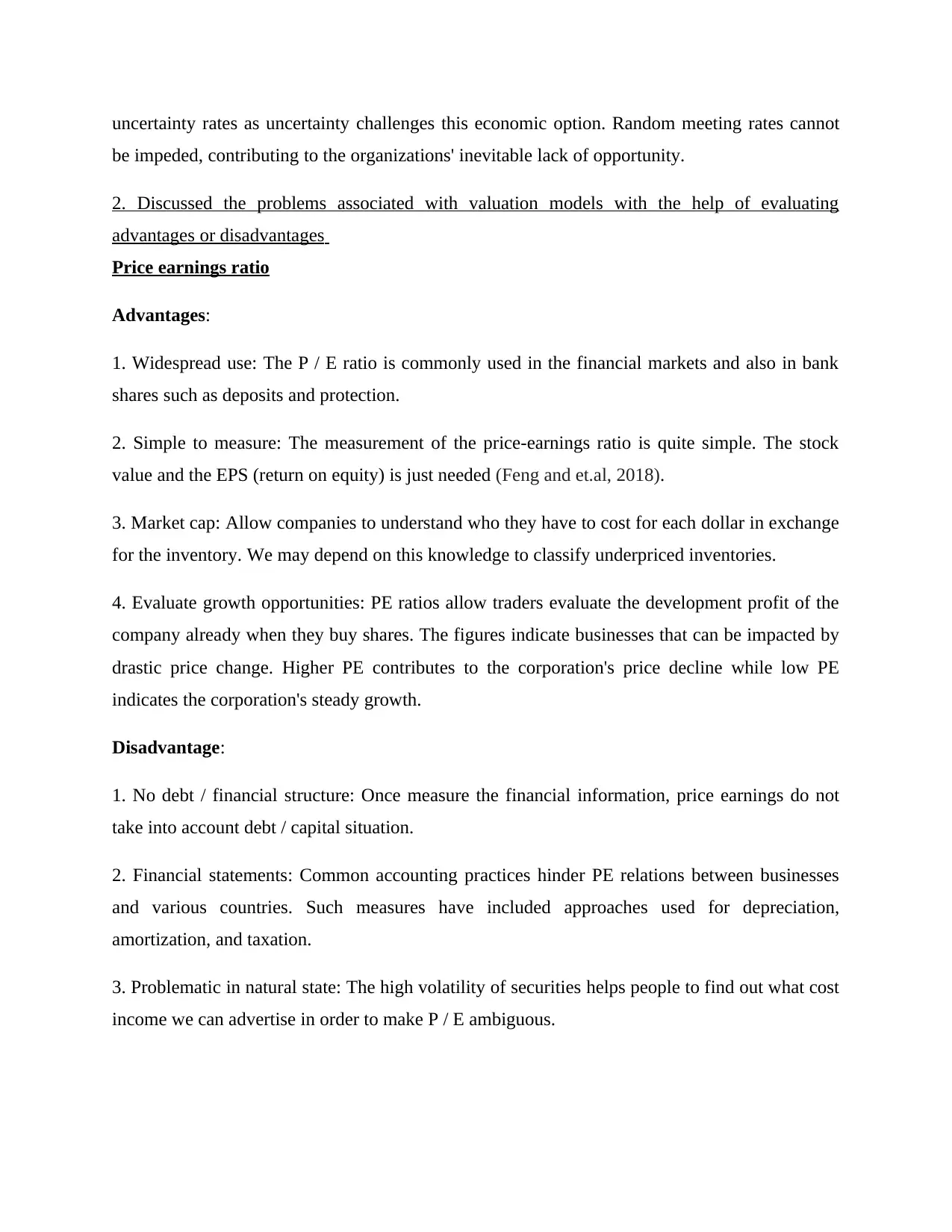
uncertainty rates as uncertainty challenges this economic option. Random meeting rates cannot
be impeded, contributing to the organizations' inevitable lack of opportunity.
2. Discussed the problems associated with valuation models with the help of evaluating
advantages or disadvantages
Price earnings ratio
Advantages:
1. Widespread use: The P / E ratio is commonly used in the financial markets and also in bank
shares such as deposits and protection.
2. Simple to measure: The measurement of the price-earnings ratio is quite simple. The stock
value and the EPS (return on equity) is just needed (Feng and et.al, 2018).
3. Market cap: Allow companies to understand who they have to cost for each dollar in exchange
for the inventory. We may depend on this knowledge to classify underpriced inventories.
4. Evaluate growth opportunities: PE ratios allow traders evaluate the development profit of the
company already when they buy shares. The figures indicate businesses that can be impacted by
drastic price change. Higher PE contributes to the corporation's price decline while low PE
indicates the corporation's steady growth.
Disadvantage:
1. No debt / financial structure: Once measure the financial information, price earnings do not
take into account debt / capital situation.
2. Financial statements: Common accounting practices hinder PE relations between businesses
and various countries. Such measures have included approaches used for depreciation,
amortization, and taxation.
3. Problematic in natural state: The high volatility of securities helps people to find out what cost
income we can advertise in order to make P / E ambiguous.
be impeded, contributing to the organizations' inevitable lack of opportunity.
2. Discussed the problems associated with valuation models with the help of evaluating
advantages or disadvantages
Price earnings ratio
Advantages:
1. Widespread use: The P / E ratio is commonly used in the financial markets and also in bank
shares such as deposits and protection.
2. Simple to measure: The measurement of the price-earnings ratio is quite simple. The stock
value and the EPS (return on equity) is just needed (Feng and et.al, 2018).
3. Market cap: Allow companies to understand who they have to cost for each dollar in exchange
for the inventory. We may depend on this knowledge to classify underpriced inventories.
4. Evaluate growth opportunities: PE ratios allow traders evaluate the development profit of the
company already when they buy shares. The figures indicate businesses that can be impacted by
drastic price change. Higher PE contributes to the corporation's price decline while low PE
indicates the corporation's steady growth.
Disadvantage:
1. No debt / financial structure: Once measure the financial information, price earnings do not
take into account debt / capital situation.
2. Financial statements: Common accounting practices hinder PE relations between businesses
and various countries. Such measures have included approaches used for depreciation,
amortization, and taxation.
3. Problematic in natural state: The high volatility of securities helps people to find out what cost
income we can advertise in order to make P / E ambiguous.
Paraphrase This Document
Need a fresh take? Get an instant paraphrase of this document with our AI Paraphraser
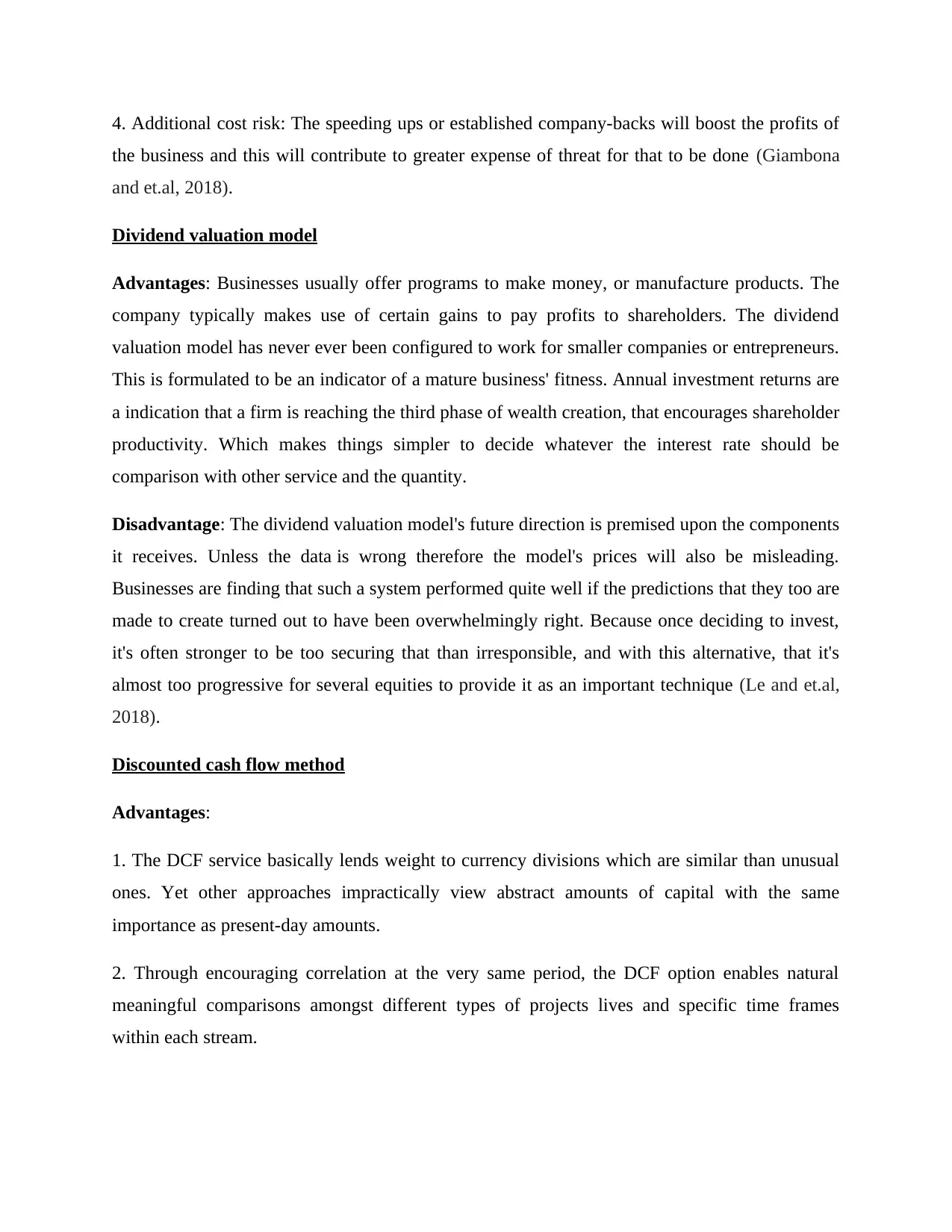
4. Additional cost risk: The speeding ups or established company-backs will boost the profits of
the business and this will contribute to greater expense of threat for that to be done (Giambona
and et.al, 2018).
Dividend valuation model
Advantages: Businesses usually offer programs to make money, or manufacture products. The
company typically makes use of certain gains to pay profits to shareholders. The dividend
valuation model has never ever been configured to work for smaller companies or entrepreneurs.
This is formulated to be an indicator of a mature business' fitness. Annual investment returns are
a indication that a firm is reaching the third phase of wealth creation, that encourages shareholder
productivity. Which makes things simpler to decide whatever the interest rate should be
comparison with other service and the quantity.
Disadvantage: The dividend valuation model's future direction is premised upon the components
it receives. Unless the data is wrong therefore the model's prices will also be misleading.
Businesses are finding that such a system performed quite well if the predictions that they too are
made to create turned out to have been overwhelmingly right. Because once deciding to invest,
it's often stronger to be too securing that than irresponsible, and with this alternative, that it's
almost too progressive for several equities to provide it as an important technique (Le and et.al,
2018).
Discounted cash flow method
Advantages:
1. The DCF service basically lends weight to currency divisions which are similar than unusual
ones. Yet other approaches impractically view abstract amounts of capital with the same
importance as present-day amounts.
2. Through encouraging correlation at the very same period, the DCF option enables natural
meaningful comparisons amongst different types of projects lives and specific time frames
within each stream.
the business and this will contribute to greater expense of threat for that to be done (Giambona
and et.al, 2018).
Dividend valuation model
Advantages: Businesses usually offer programs to make money, or manufacture products. The
company typically makes use of certain gains to pay profits to shareholders. The dividend
valuation model has never ever been configured to work for smaller companies or entrepreneurs.
This is formulated to be an indicator of a mature business' fitness. Annual investment returns are
a indication that a firm is reaching the third phase of wealth creation, that encourages shareholder
productivity. Which makes things simpler to decide whatever the interest rate should be
comparison with other service and the quantity.
Disadvantage: The dividend valuation model's future direction is premised upon the components
it receives. Unless the data is wrong therefore the model's prices will also be misleading.
Businesses are finding that such a system performed quite well if the predictions that they too are
made to create turned out to have been overwhelmingly right. Because once deciding to invest,
it's often stronger to be too securing that than irresponsible, and with this alternative, that it's
almost too progressive for several equities to provide it as an important technique (Le and et.al,
2018).
Discounted cash flow method
Advantages:
1. The DCF service basically lends weight to currency divisions which are similar than unusual
ones. Yet other approaches impractically view abstract amounts of capital with the same
importance as present-day amounts.
2. Through encouraging correlation at the very same period, the DCF option enables natural
meaningful comparisons amongst different types of projects lives and specific time frames
within each stream.
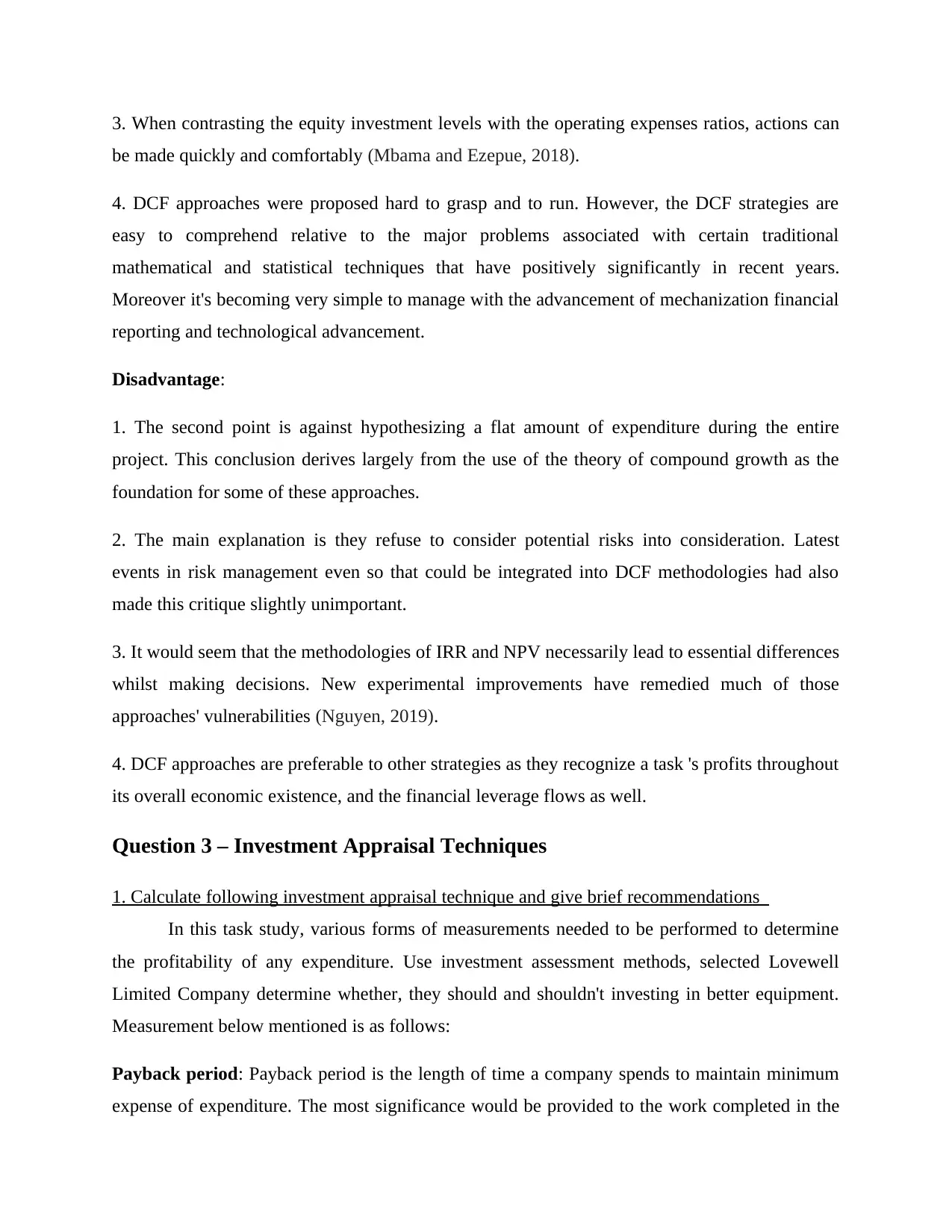
3. When contrasting the equity investment levels with the operating expenses ratios, actions can
be made quickly and comfortably (Mbama and Ezepue, 2018).
4. DCF approaches were proposed hard to grasp and to run. However, the DCF strategies are
easy to comprehend relative to the major problems associated with certain traditional
mathematical and statistical techniques that have positively significantly in recent years.
Moreover it's becoming very simple to manage with the advancement of mechanization financial
reporting and technological advancement.
Disadvantage:
1. The second point is against hypothesizing a flat amount of expenditure during the entire
project. This conclusion derives largely from the use of the theory of compound growth as the
foundation for some of these approaches.
2. The main explanation is they refuse to consider potential risks into consideration. Latest
events in risk management even so that could be integrated into DCF methodologies had also
made this critique slightly unimportant.
3. It would seem that the methodologies of IRR and NPV necessarily lead to essential differences
whilst making decisions. New experimental improvements have remedied much of those
approaches' vulnerabilities (Nguyen, 2019).
4. DCF approaches are preferable to other strategies as they recognize a task 's profits throughout
its overall economic existence, and the financial leverage flows as well.
Question 3 – Investment Appraisal Techniques
1. Calculate following investment appraisal technique and give brief recommendations
In this task study, various forms of measurements needed to be performed to determine
the profitability of any expenditure. Use investment assessment methods, selected Lovewell
Limited Company determine whether, they should and shouldn't investing in better equipment.
Measurement below mentioned is as follows:
Payback period: Payback period is the length of time a company spends to maintain minimum
expense of expenditure. The most significance would be provided to the work completed in the
be made quickly and comfortably (Mbama and Ezepue, 2018).
4. DCF approaches were proposed hard to grasp and to run. However, the DCF strategies are
easy to comprehend relative to the major problems associated with certain traditional
mathematical and statistical techniques that have positively significantly in recent years.
Moreover it's becoming very simple to manage with the advancement of mechanization financial
reporting and technological advancement.
Disadvantage:
1. The second point is against hypothesizing a flat amount of expenditure during the entire
project. This conclusion derives largely from the use of the theory of compound growth as the
foundation for some of these approaches.
2. The main explanation is they refuse to consider potential risks into consideration. Latest
events in risk management even so that could be integrated into DCF methodologies had also
made this critique slightly unimportant.
3. It would seem that the methodologies of IRR and NPV necessarily lead to essential differences
whilst making decisions. New experimental improvements have remedied much of those
approaches' vulnerabilities (Nguyen, 2019).
4. DCF approaches are preferable to other strategies as they recognize a task 's profits throughout
its overall economic existence, and the financial leverage flows as well.
Question 3 – Investment Appraisal Techniques
1. Calculate following investment appraisal technique and give brief recommendations
In this task study, various forms of measurements needed to be performed to determine
the profitability of any expenditure. Use investment assessment methods, selected Lovewell
Limited Company determine whether, they should and shouldn't investing in better equipment.
Measurement below mentioned is as follows:
Payback period: Payback period is the length of time a company spends to maintain minimum
expense of expenditure. The most significance would be provided to the work completed in the
⊘ This is a preview!⊘
Do you want full access?
Subscribe today to unlock all pages.

Trusted by 1+ million students worldwide
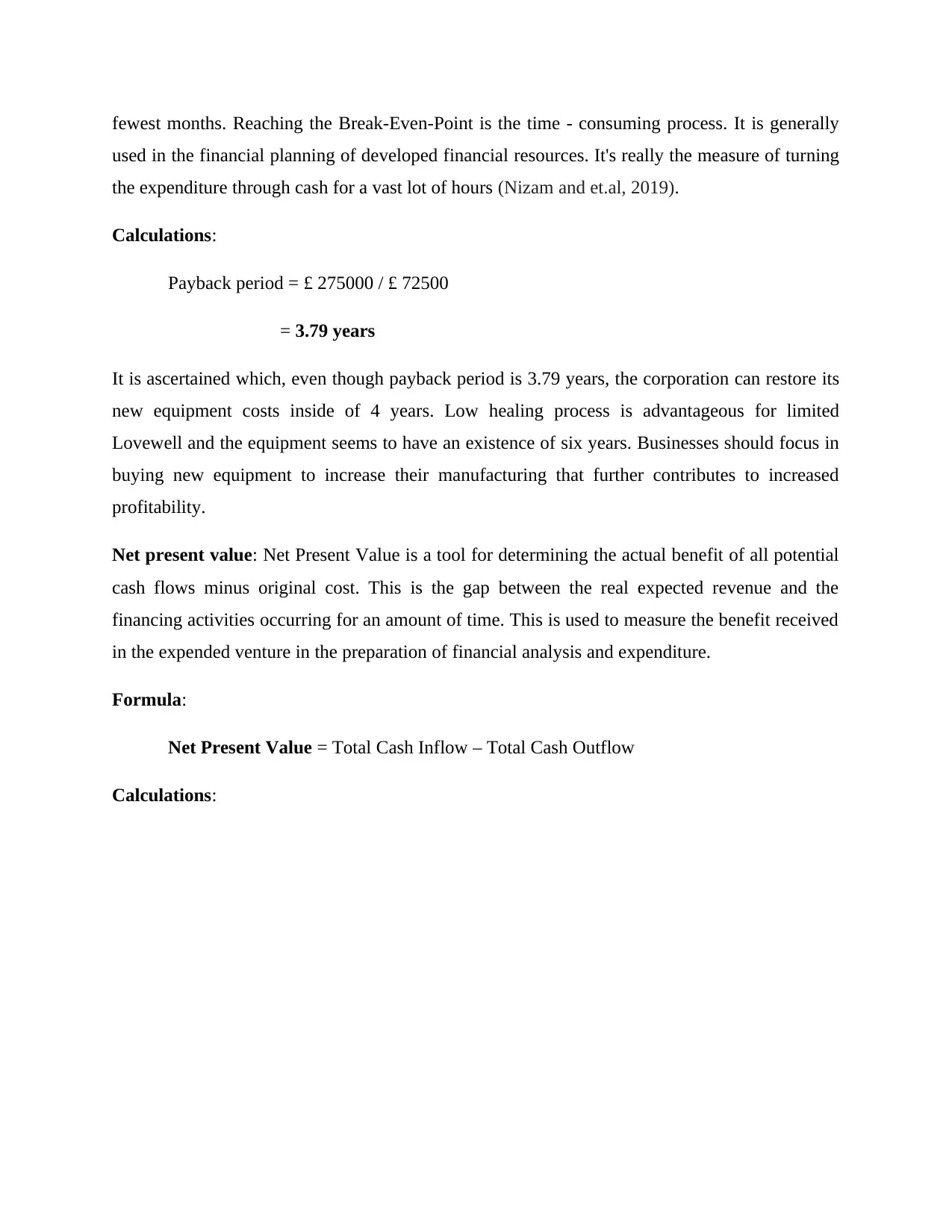
fewest months. Reaching the Break-Even-Point is the time - consuming process. It is generally
used in the financial planning of developed financial resources. It's really the measure of turning
the expenditure through cash for a vast lot of hours (Nizam and et.al, 2019).
Calculations:
Payback period = £ 275000 / £ 72500
= 3.79 years
It is ascertained which, even though payback period is 3.79 years, the corporation can restore its
new equipment costs inside of 4 years. Low healing process is advantageous for limited
Lovewell and the equipment seems to have an existence of six years. Businesses should focus in
buying new equipment to increase their manufacturing that further contributes to increased
profitability.
Net present value: Net Present Value is a tool for determining the actual benefit of all potential
cash flows minus original cost. This is the gap between the real expected revenue and the
financing activities occurring for an amount of time. This is used to measure the benefit received
in the expended venture in the preparation of financial analysis and expenditure.
Formula:
Net Present Value = Total Cash Inflow – Total Cash Outflow
Calculations:
used in the financial planning of developed financial resources. It's really the measure of turning
the expenditure through cash for a vast lot of hours (Nizam and et.al, 2019).
Calculations:
Payback period = £ 275000 / £ 72500
= 3.79 years
It is ascertained which, even though payback period is 3.79 years, the corporation can restore its
new equipment costs inside of 4 years. Low healing process is advantageous for limited
Lovewell and the equipment seems to have an existence of six years. Businesses should focus in
buying new equipment to increase their manufacturing that further contributes to increased
profitability.
Net present value: Net Present Value is a tool for determining the actual benefit of all potential
cash flows minus original cost. This is the gap between the real expected revenue and the
financing activities occurring for an amount of time. This is used to measure the benefit received
in the expended venture in the preparation of financial analysis and expenditure.
Formula:
Net Present Value = Total Cash Inflow – Total Cash Outflow
Calculations:
Paraphrase This Document
Need a fresh take? Get an instant paraphrase of this document with our AI Paraphraser
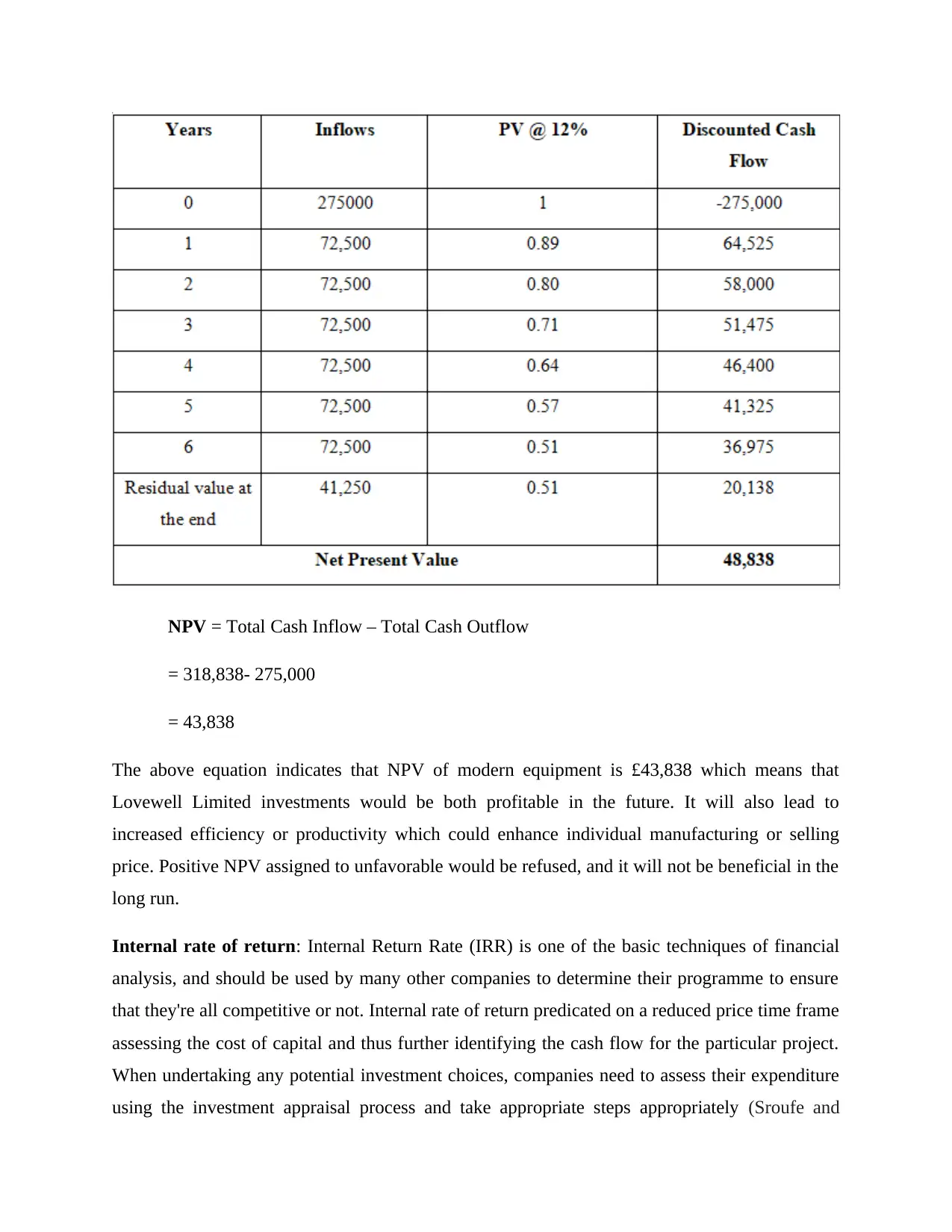
NPV = Total Cash Inflow – Total Cash Outflow
= 318,838- 275,000
= 43,838
The above equation indicates that NPV of modern equipment is £43,838 which means that
Lovewell Limited investments would be both profitable in the future. It will also lead to
increased efficiency or productivity which could enhance individual manufacturing or selling
price. Positive NPV assigned to unfavorable would be refused, and it will not be beneficial in the
long run.
Internal rate of return: Internal Return Rate (IRR) is one of the basic techniques of financial
analysis, and should be used by many other companies to determine their programme to ensure
that they're all competitive or not. Internal rate of return predicated on a reduced price time frame
assessing the cost of capital and thus further identifying the cash flow for the particular project.
When undertaking any potential investment choices, companies need to assess their expenditure
using the investment appraisal process and take appropriate steps appropriately (Sroufe and
= 318,838- 275,000
= 43,838
The above equation indicates that NPV of modern equipment is £43,838 which means that
Lovewell Limited investments would be both profitable in the future. It will also lead to
increased efficiency or productivity which could enhance individual manufacturing or selling
price. Positive NPV assigned to unfavorable would be refused, and it will not be beneficial in the
long run.
Internal rate of return: Internal Return Rate (IRR) is one of the basic techniques of financial
analysis, and should be used by many other companies to determine their programme to ensure
that they're all competitive or not. Internal rate of return predicated on a reduced price time frame
assessing the cost of capital and thus further identifying the cash flow for the particular project.
When undertaking any potential investment choices, companies need to assess their expenditure
using the investment appraisal process and take appropriate steps appropriately (Sroufe and
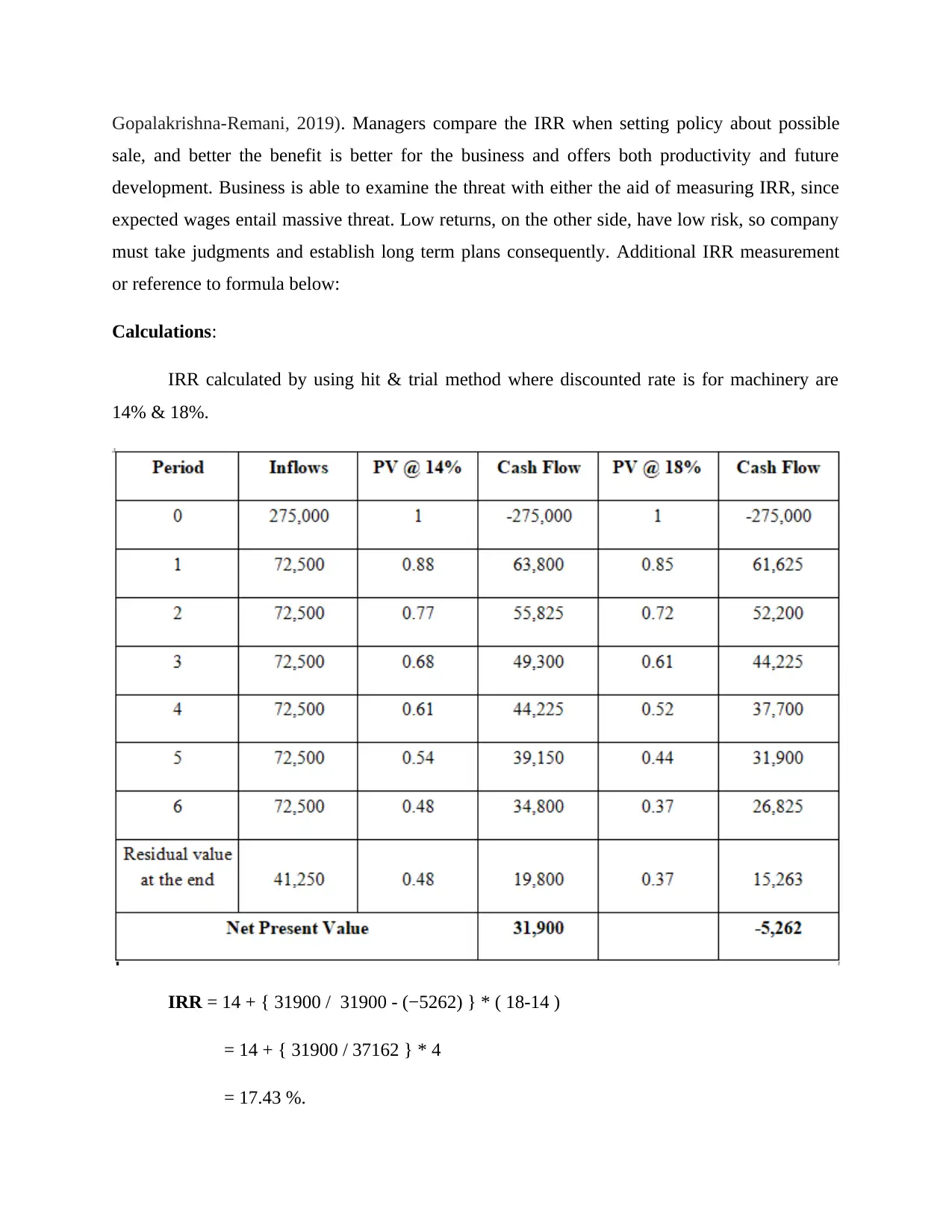
Gopalakrishna-Remani, 2019). Managers compare the IRR when setting policy about possible
sale, and better the benefit is better for the business and offers both productivity and future
development. Business is able to examine the threat with either the aid of measuring IRR, since
expected wages entail massive threat. Low returns, on the other side, have low risk, so company
must take judgments and establish long term plans consequently. Additional IRR measurement
or reference to formula below:
Calculations:
IRR calculated by using hit & trial method where discounted rate is for machinery are
14% & 18%.
IRR = 14 + { 31900 / 31900 - (−5262) } * ( 18-14 )
= 14 + { 31900 / 37162 } * 4
= 17.43 %.
sale, and better the benefit is better for the business and offers both productivity and future
development. Business is able to examine the threat with either the aid of measuring IRR, since
expected wages entail massive threat. Low returns, on the other side, have low risk, so company
must take judgments and establish long term plans consequently. Additional IRR measurement
or reference to formula below:
Calculations:
IRR calculated by using hit & trial method where discounted rate is for machinery are
14% & 18%.
IRR = 14 + { 31900 / 31900 - (−5262) } * ( 18-14 )
= 14 + { 31900 / 37162 } * 4
= 17.43 %.
⊘ This is a preview!⊘
Do you want full access?
Subscribe today to unlock all pages.

Trusted by 1+ million students worldwide
1 out of 18
Related Documents
Your All-in-One AI-Powered Toolkit for Academic Success.
+13062052269
info@desklib.com
Available 24*7 on WhatsApp / Email
![[object Object]](/_next/static/media/star-bottom.7253800d.svg)
Unlock your academic potential
Copyright © 2020–2025 A2Z Services. All Rights Reserved. Developed and managed by ZUCOL.




